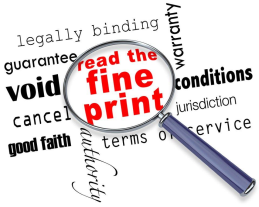Leasing business equipment often seems to be a less-expensive procurement option than purchasing, but that determination may not be accurate if the true risks of equipment leasing aren’t factored into the lease vs. buy analysis.
Failing to recognize risk can also lead to unwise lessor selection, based almost solely on rate and not the actual all-in costs of the lease.
 For these reasons, enterprises that are considering leasing their business equipment need to be able to identify all risks and quantify the associated cost based on historical lease performance.
For these reasons, enterprises that are considering leasing their business equipment need to be able to identify all risks and quantify the associated cost based on historical lease performance.
The pitfalls of leasing business equipment are many, but these five risks are among the most common that cause business equipment costs to escalate well beyond the cost of the lease term rent.
1. Soft costs.
Services, software and other "soft" costs will vary depending on the type of office and kind of equipment, but they can be substantial. There are two main issued with soft cost: 1. Lessors generally do not invest any equity into the soft costs, so therefore lessees are paying for 100% of the soft costs over the term, plus interest and additional lease costs. 2. In some cases, soft costs can create significant end of lease risk (lessors may require that software be returned just like hardware) unless treated differently than returnable assets.
2. Fees and charges.
Many business equipment leases contain various service fees (administrative fees, restocking fees, security deposits, etc.). If these fees are not reasonable and capped, they can become a significant, ongoing drag on income. In many cases, lessees end up paying more for service than they could if they had purchased the equipment and hired a third party for service management.
3. Using the wrong lease structure for the asset type.
 For example, a fair market value back-end lease should never be used for vehicles when a form of TRAC (Terminal Rental Adjustment Clause) lease is available, because the risks are too great and costs can spiral out of control. In a TRAC lease, the residual value for the leased vehicle is established at the beginning of the lease. At the end of the lease, the lessee can buy the vehicle or continue leasing by financing the predetermined residual value. If a lessee structures the lease agreement properly, it will also be able to return or trade equipment during the lease.
For example, a fair market value back-end lease should never be used for vehicles when a form of TRAC (Terminal Rental Adjustment Clause) lease is available, because the risks are too great and costs can spiral out of control. In a TRAC lease, the residual value for the leased vehicle is established at the beginning of the lease. At the end of the lease, the lessee can buy the vehicle or continue leasing by financing the predetermined residual value. If a lessee structures the lease agreement properly, it will also be able to return or trade equipment during the lease.
4. Being unable to return the business equipment because it’s too distributed.
Particularly with IT equipment, the equipment can be so dispersed that return is virtually impossible from a logistical perspective, especially to the contract specifications. Many times, lessees literally don’t know where all the equipment on a lease schedule is located.
Additionally, the equipment will likely be used in varied ways, some of which are fulfilling urgent and ongoing needs. This variety of use can easily lead to difficulty in coordinating a return. The departments using the equipment often aren’t ready to part with it when the lease ends.
5. Being unable to uninstall large pieces of equipment.
Sometimes the problem isn’t locating the equipment for return. Large pieces of vital equipment will be “right there.” But many times, this large equipment can’t be returned on time per the contract terms because it would derail operations. When equipment is not returned on time and a lease extends, the underlying economics of the lease rapidly get flipped upside down.
Conclusion
Business equipment leasing has many risks — many of them related to end-of-lease terms. Before entering into any lease for business equipment, an enterprise needs to thoroughly understand the historical cost implications of lease risk, make a realistic assessment of the probability of return, and cap risk exposures in the leasing terms in the underlying equipment lease agreements as much as possible.



